When it comes to tiny birds, parrotlets are the most adorable ones. Parrotlets are small, intelligent birds that have gained popularity as pets in recent years. These pint-sized parrots have captivating personalities and vibrant plumage, making them an appealing choice for bird enthusiasts.
However, like any pet, parrotlets come with their own set of pros and cons. While they are highly social and intelligent, they can be aggressive if you don’t pay proper attention to them.
Read on as we will explore the advantages and disadvantages of keeping parrotlets as pets, helping you make an informed decision before buying one.
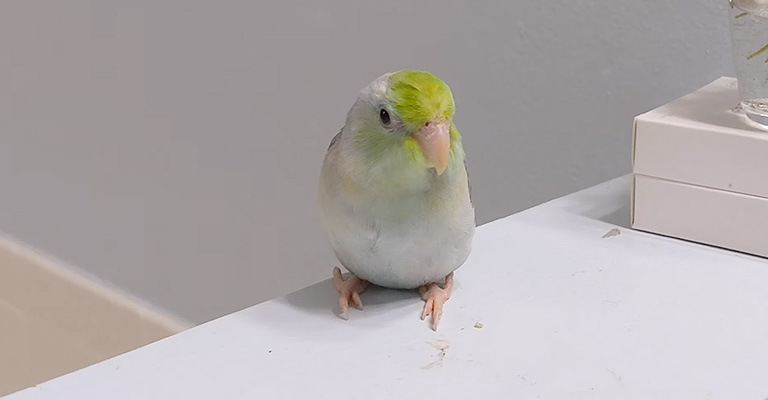
What Does A Parrolet Look Like?
Parrotlets, also known as pocket parrots, are small parrots that belong to the genus Forpus. They have several notable features that distinguish them from other parrot species. Here are some characteristics of parrotlets:
Size and Shape
- Parrotlets are small-sized parrots, typically measuring around 4.5 to 5.5 inches (11 to 14 centimetres) in length.
- They have a compact and stocky build with a rounded head and a short, square-shaped tail.
Plumage
- Parrotlets come in various vibrant colors, including green, blue, yellow, and turquoise shades.
- The exact colouration depends on the specific species and mutations.
- Their feathers are dense and smooth, giving them a sleek appearance.
Beak and Eyes
- Parrotlets have a small, curved beak designed for cracking and eating seeds and fruits.
- The beak color can vary, but it is usually light-colored, such as yellow or light grey.
- They have large, round, and expressive eyes, typically dark in color.
Wing and Tail Feathers
- Parrotlets have short, rounded wings allowing them to manoeuvre swiftly and navigate their surroundings.
- The primary wing feathers and secondary flight feathers are typically darker in color, providing contrast to the body plumage.
- Their tail feathers are relatively short and squared off.
Gender Differences
- In some parrotlet species, there are visible differences between males and females.
- For example, male Pacific parrotlets have bright blue feathers on their wings and back, while females have more muted green colors.
- It is important to note that not all parrotlet species exhibit noticeable sexual dimorphism, and DNA or surgical sexing may be required for accurate gender identification.
Are Parrolets Social and Friendly?
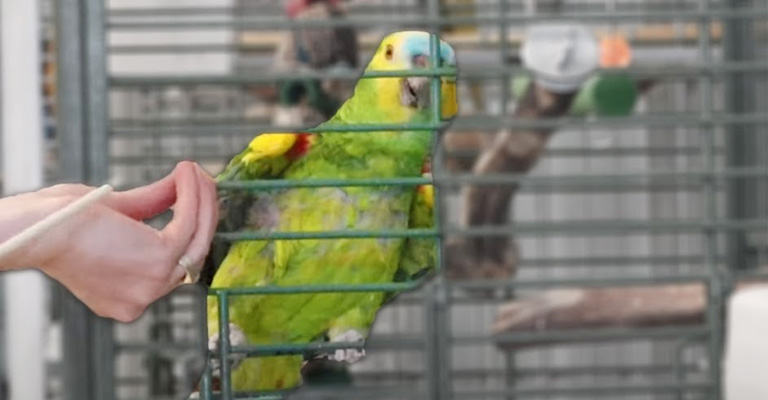
Yes, parrotlets are generally considered to be social and friendly birds. They have the potential to form strong bonds with their human caregivers and can develop a deep sense of trust and affection.
With proper socialization and positive reinforcement, parrotlets can become quite friendly and interactive pets. Here are some of their features-
Social Nature
Parrotlets have a social nature and enjoy spending time with their human companions. They thrive on social interaction and mental stimulation. While they may not be as outgoing as some larger parrot species, they still enjoy being part of their human family’s activities.
Bonding and Interaction
Parrotlets have the capacity to form strong bonds with their owners. They often exhibit playful behavior and may enjoy interactive games, such as retrieving small toys or learning simple tricks. Regular handling and positive interaction can help foster a strong bond and enhance their socialization skills.
Communication Skills
Parrotlets are known for their vocalizations, and they use various sounds and calls to communicate with their owners.
They can learn to mimic certain words or phrases, although they are not as proficient as some larger parrot species. However, their charming chirps and melodic sounds can still create an engaging and interactive environment.
Considerations for Socialization
To ensure a parrotlet’s social development, it is important to provide them with ample opportunities for socialization. This includes spending time together, offering mental stimulation through toys and puzzles, and providing a safe and enriching environment.
Is It Difficult to Take Care of Parrolets?
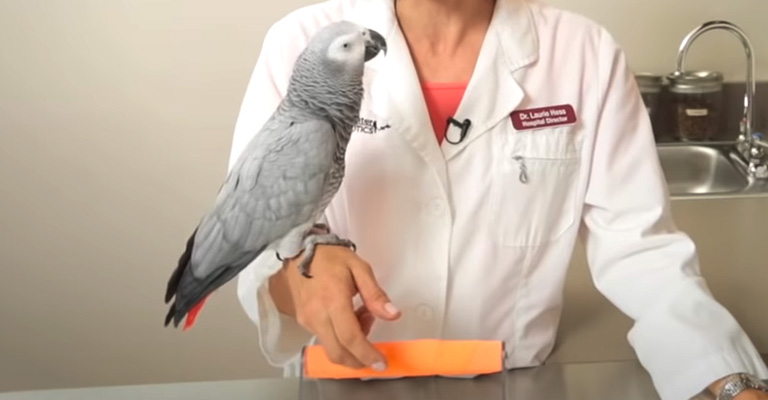
Although parrotlets are tiny birds with affectionate personalities, they can be a bit difficult to handle. Below are the different aspects of parrotlet care-
Takes Less Space
Parrotlets are small birds, typically measuring around 5-6 inches in length. Their compact size makes them easier to handle and accommodate in terms of housing and transportation.
Low Noise Level
Compared to larger parrot species, Parrotlets have a relatively lower noise level. They are known for their melodious chirping rather than loud screeching, making them suitable for apartment living or noise-sensitive environments.
Independent Nature
As parrotlets are relatively independent birds, they can entertain themselves with toys and activities. They don’t require constant attention or interaction, making them suitable for individuals or families with busy schedules.
Feisty Personality
Some parrotlets have a reputation for being feisty and assertive. While their spirited nature can be endearing, it may pose challenges for inexperienced bird owners. They can display territorial behavior and may nip or bite if they feel threatened or provoked.
Specialized Diet
Parrotlets require a balanced and varied diet consisting of high-quality pellets, fresh fruits, vegetables, and occasional treats. Providing a nutritionally complete diet can be challenging, as some Parrotlets can be picky eaters and may need time to adjust to new food items.
Enrichment and Mental Stimulation
Parrotlets are intelligent birds that require mental stimulation and enrichment to prevent boredom and behavioral issues. They need a variety of toys, puzzles, and interactive activities to keep them mentally engaged, which may require some effort and creativity on the owner’s part.
How Are Parrotlets with Other Pets?
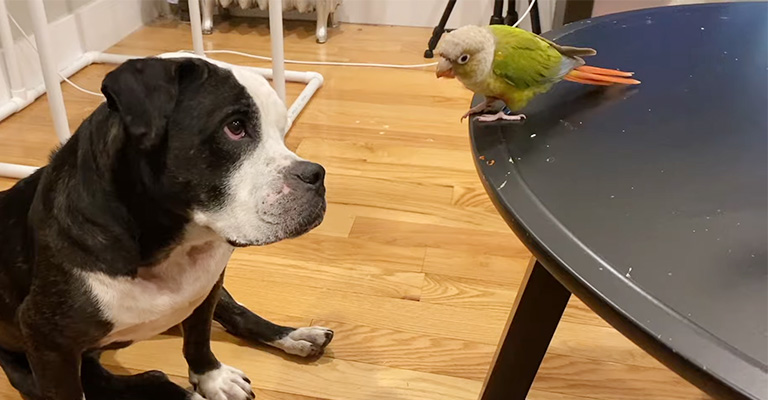
Parrotlets, like any other pet bird, can have varying levels of compatibility with other pets. Their interactions with other animals depend on a variety of factors, including the individual personalities of the pets involved, their socialization history, and the way they are introduced to each other.
Here are some general considerations regarding parrotlets and other pets:
Other Birds
As parrotlets are generally social birds, they may enjoy the company of other parrotlets or similarly sized birds if properly introduced and given enough space.
However, it’s important to monitor their interactions closely to ensure they get along and do not become aggressive or territorial.
Dogs
Introducing a parrotlet to a dog requires careful supervision and gradual acclimation. Dogs with a high prey drive may view the bird as a potential target, so it’s crucial to teach your dog to remain calm and gentle around the parrotlet. Always keep them separated when you are unable to supervise their interactions.
Cats
Cats are natural hunters, and their predatory instincts can pose a significant risk to parrotlets. It’s generally not recommended to keep parrotlets and cats together without strict supervision.
Even if a cat seems friendly, their instincts may kick in suddenly, leading to harm to the bird. Ensure that your parrotlet’s enclosure is secure and inaccessible to the cat.
Small Mammals
The compatibility of parrotlets with small mammals, such as hamsters, guinea pigs, or rabbits, depends on the individual animals involved.
Some parrotlets may show curiosity towards these small mammals, while others may display aggression. It’s essential to monitor their interactions closely and separate them if any signs of stress or aggression are observed.
Do Parrotlets Have Major Health Issues?
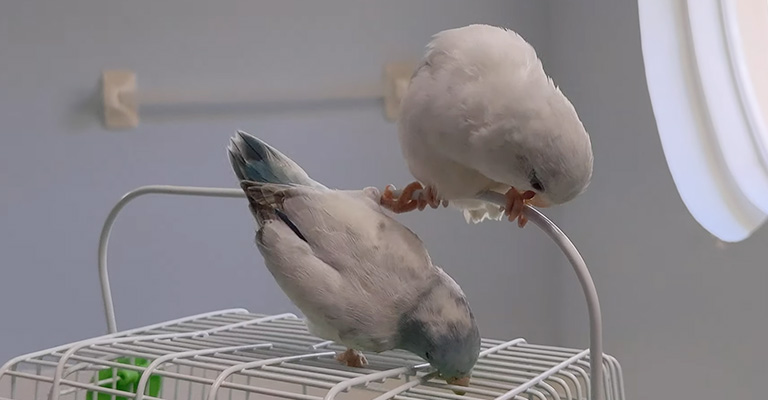
Parrotlets are generally considered healthy birds but can still experience specific health issues. Here are some major health concerns associated with parrotlets:
Respiratory Infections
Parrotlets can be susceptible to respiratory infections caused by bacteria, viruses, or fungi. Symptoms may include wheezing, coughing, sneezing, nasal discharge, or difficulty breathing.
Proper ventilation, a clean environment, and regular veterinary check-ups can help prevent and address respiratory issues.
Feather Plucking and Self-Mutilation:
Like other parrot species, parrotlets may develop a habit of feather plucking or self-mutilation. This behavior can be triggered by stress, boredom, illness, or other underlying issues.
Providing mental stimulation, a varied and enriching environment, and addressing underlying causes are crucial to managing this behavior.
Psittacine Beak and Feather Disease (PBFD):
PBFD is a viral disease primarily affecting parrots and can lead to severe feather loss, beak deformities, and immune system suppression.
It is highly contagious and can be transmitted through feather dust, feces, or contaminated surfaces. Regular veterinary check-ups, proper hygiene, and avoiding contact with infected birds are essential for prevention.
Obesity and Nutritional Disorders
Parrotlets can be prone to obesity if not provided with a balanced diet and appropriate portion sizes. Nutritional deficiencies, such as calcium or vitamin deficiencies, can also occur if the diet needs to be correctly balanced. A varied diet of high-quality pellets, fresh fruits, vegetables, and occasional treats can help maintain their overall health.
Egg Binding:
Female parrotlets may experience complications during egg-laying, leading to egg binding. This occurs when an egg becomes stuck in the reproductive tract, causing discomfort and potential health risks. Providing a suitable nesting area, a proper diet, and monitoring egg-laying behavior can help reduce the risk of egg binding.
Are Parrotlets Expensive?
Regarding the cost of Parrotlets, their prices can vary depending on factors such as their color mutation, age, and availability in your area. Generally, Parrotlets are considered to be more affordable compared to larger parrot species.
However, the cost of purchasing a Parrotlet is just one aspect to consider. You also need to budget for ongoing expenses such as housing, food, toys, veterinary care, and other supplies. These costs can add up over time. It’s important to research and consider all the financial aspects before deciding to bring a Parrotlet into your home.
FAQs
Parrotlets can be suitable for beginners due to their small size and lower maintenance needs compared to larger parrot species. They are generally less demanding in terms of space and time, making them more manageable for first-time bird owners.
Parrotlets are known for forming strong bonds with their owners. They can develop a deep affection and loyalty towards their primary caregiver, which can result in a close and interactive relationship.
Parrotlets are generally less noisy compared to larger parrot species. However, they are still capable of vocalizing and can occasionally produce loud calls or chirps, especially when they feel threatened or stressed.
Parrotlets have a relatively long lifespan compared to many other small pet birds. On average, they can live anywhere from 15 to 20 years or even longer with proper care, diet, and a suitable environment.
Parrotlets are social birds and thrive on a regular interaction and mental stimulation. They need daily socialization, playtime, and out-of-cage activities to keep them mentally and physically engaged. They require dedicated time and attention from their owners to prevent boredom and potential behavior problems.
Final Verdict
That was all about parrotlets as pets pros and cons. Parrotlets can make delightful and entertaining pets for those willing to invest time, effort, and patience in their care. Their intelligence, social nature, and colorful personalities can bring immense joy to their owners’ lives.
However, the health risks, occasional aggressive behavior, and the need for continuous mental stimulation are factors that potential owners should consider before bringing a parrotlet home.